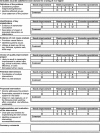Validation of a method for assessing resident physicians' quality improvement proposals
- PMID: 17602270
- PMCID: PMC2219765
- DOI: 10.1007/s11606-007-0260-y
Validation of a method for assessing resident physicians' quality improvement proposals
Abstract
Background: Residency programs involve trainees in quality improvement (QI) projects to evaluate competency in systems-based practice and practice-based learning and improvement. Valid approaches to assess QI proposals are lacking.
Objective: We developed an instrument for assessing resident QI proposals--the Quality Improvement Proposal Assessment Tool (QIPAT-7)-and determined its validity and reliability.
Design: QIPAT-7 content was initially obtained from a national panel of QI experts. Through an iterative process, the instrument was refined, pilot-tested, and revised.
Participants: Seven raters used the instrument to assess 45 resident QI proposals.
Measurements: Principal factor analysis was used to explore the dimensionality of instrument scores. Cronbach's alpha and intraclass correlations were calculated to determine internal consistency and interrater reliability, respectively.
Results: QIPAT-7 items comprised a single factor (eigenvalue = 3.4) suggesting a single assessment dimension. Interrater reliability for each item (range 0.79 to 0.93) and internal consistency reliability among the items (Cronbach's alpha = 0.87) were high.
Conclusions: This method for assessing resident physician QI proposals is supported by content and internal structure validity evidence. QIPAT-7 is a useful tool for assessing resident QI proposals. Future research should determine the reliability of QIPAT-7 scores in other residency and fellowship training programs. Correlations should also be made between assessment scores and criteria for QI proposal success such as implementation of QI proposals, resident scholarly productivity, and improved patient outcomes.
Figures

Similar articles
-
Validation of a method to measure resident doctors' reflections on quality improvement.Med Educ. 2010 Mar;44(3):248-55. doi: 10.1111/j.1365-2923.2009.03591.x. Med Educ. 2010. PMID: 20444055
-
The development and assessment of an evaluation tool for pediatric resident competence in leading simulated pediatric resuscitations.Resuscitation. 2012 Jul;83(7):887-93. doi: 10.1016/j.resuscitation.2012.01.015. Epub 2012 Jan 28. Resuscitation. 2012. PMID: 22286047
-
Relationship between critical reflection and quality improvement proposal scores in resident doctors.Med Educ. 2011 Feb;45(2):149-54. doi: 10.1111/j.1365-2923.2010.03860.x. Epub 2010 Dec 17. Med Educ. 2011. PMID: 21166692
-
The Development of an Instrument for Faculty to Assess Resident-Led Large Group Teaching.Acad Pediatr. 2020 May-Jun;20(4):442-447. doi: 10.1016/j.acap.2019.10.010. Epub 2019 Oct 17. Acad Pediatr. 2020. PMID: 31629942 Review.
-
Development of a Tool to Assess Trainees' Ability to Design and Conduct Quality Improvement Projects.Am J Med Qual. 2020 Mar/Apr;35(2):125-132. doi: 10.1177/1062860619853880. Epub 2019 Jun 12. Am J Med Qual. 2020. PMID: 31189327 Review.
Cited by
-
Author's Reply to Professionalism-The Role of Quality Improvement.Rambam Maimonides Med J. 2015 Jul 30;6(3):e0035. doi: 10.5041/RMMJ.10220. Rambam Maimonides Med J. 2015. PMID: 26241224 Free PMC article. No abstract available.
-
Development of a Multi-Domain Assessment Tool for Quality Improvement Projects.J Grad Med Educ. 2017 Aug;9(4):473-478. doi: 10.4300/JGME-D-17-00041.1. J Grad Med Educ. 2017. PMID: 28824761 Free PMC article.
-
A Learning Community Supporting Experiential Education to Learn About Healthcare Equity Quality Improvement.J Gen Intern Med. 2023 Oct;38(13):3060-3064. doi: 10.1007/s11606-023-08314-0. Epub 2023 Jul 24. J Gen Intern Med. 2023. PMID: 37488367 Free PMC article.
-
A quality improvement activity to promote interprofessional collaboration among health professions students.Am J Pharm Educ. 2009 Jul 10;73(4):64. doi: 10.5688/aj730464. Am J Pharm Educ. 2009. PMID: 19657497 Free PMC article.
-
Pilot study evaluating a practice-based learning and improvement curriculum focusing on the development of system-level quality improvement skills.J Grad Med Educ. 2011 Mar;3(1):49-58. doi: 10.4300/JGME-D-10-00104.1. J Grad Med Educ. 2011. PMID: 22379523 Free PMC article.
References
-
- ACGME Outcome Project. Available at: http://www.acgme.org/outcome/comp/compFull.asp. Accessed July 29, 2006.
-
- {'text': '', 'ref_index': 1, 'ids': [{'type': 'DOI', 'value': '10.1097/00001888-199311000-00003', 'is_inner': False, 'url': 'https://doi.org/10.1097/00001888-199311000-00003'}, {'type': 'PubMed', 'value': '8216646', 'is_inner': True, 'url': 'https://pubmed.ncbi.nlm.nih.gov/8216646/'}]}
- Ashton CM. “Invisible” doctors: making a case for involving medical residents in hospital quality improvement programs. Acad Med. 1993;68(11):823–4. - PubMed
-
- {'text': '', 'ref_index': 1, 'ids': [{'type': 'PubMed', 'value': '9544181', 'is_inner': True, 'url': 'https://pubmed.ncbi.nlm.nih.gov/9544181/'}]}
- Headrick LA, Richardson A, Priebe GP. Continuous improvement learning for residents. Pediatrics. 1998;101(4 Pt 2):768–73; discussion 773–4. - PubMed
-
- {'text': '', 'ref_index': 1, 'ids': [{'type': 'DOI', 'value': '10.1001/archinte.154.16.1829', 'is_inner': False, 'url': 'https://doi.org/10.1001/archinte.154.16.1829'}, {'type': 'PubMed', 'value': '8053750', 'is_inner': True, 'url': 'https://pubmed.ncbi.nlm.nih.gov/8053750/'}]}
- Parenti CM, Lederle FA, Impola CL, Peterson LR. Reduction of unnecessary intravenous catheter use. Internal medicine house staff participate in a successful quality improvement project. Arch Intern Med. 1994;154(16):1829–32. - PubMed
-
- {'text': '', 'ref_index': 1, 'ids': [{'type': 'DOI', 'value': '10.1046/j.1365-2923.2003.01598.x', 'is_inner': False, 'url': 'https://doi.org/10.1046/j.1365-2923.2003.01598.x'}, {'type': 'PubMed', 'value': '12950941', 'is_inner': True, 'url': 'https://pubmed.ncbi.nlm.nih.gov/12950941/'}]}
- Frey K, Edwards F, Altman K, Spahr N, Gorman RS. The ‘Collaborative Care’ curriculum: an educational model addressing key ACGME core competencies in primary care residency training [see comment]. Med Educ. 2003;37(9):786–9. - PubMed
Publication types
MeSH terms
LinkOut - more resources
Full Text Sources

